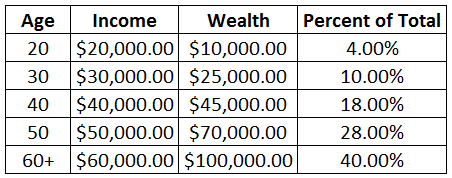Every summer we can rent a cottage
In the Isle of Wright
If it's not too dear
We shall scrimp and save
--The Beatles
In a previous post, we highlighted a common problem in studies of economic inequality--the commingling of income and wealth data. Another issue involves income and wealth differences by age.
Suppose that all people entered the workforce at age 20 s making $20,000/yr. Each decade, they get a $10,000/yr raise. They also save 5% of their income annually and get no return on their savings. Assuming the same number of people in each ten year age bracket, the distribution of income and end-of-age-bracket wealth would resemble the following:
Those aged 50 or older own more than 2/3 of the wealth.
The above model assumes equal work skills, similar saving habits, and no returns on savings. Sprinkle more reality into the example and the distribution skews more.
Age alone creates economic inequality.
Subscribe to:
Post Comments (Atom)

![[Most Recent Quotes from www.kitco.com]](http://www.kitconet.com/charts/metals/gold/t24_au_en_usoz_2.gif)



1 comment:
Any city, however small, is in fact divided into two, one the city of the poor, the other of the rich; these are at war with one another.
~Plato, 427-347 BC
Post a Comment